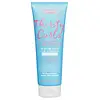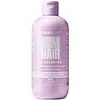What's inside
What's inside
 Key Ingredients
Key Ingredients

 Benefits
Benefits

 Concerns
Concerns

 Ingredients Side-by-side
Ingredients Side-by-side

Water
Skin ConditioningGlycerin
HumectantCetearyl Alcohol
EmollientPropylene Glycol
HumectantBehentrimonium Chloride
PreservativeHydroxyethylcellulose
Emulsion StabilisingCetrimonium Chloride
AntimicrobialPhenoxyethanol
PreservativePolyquaternium-37
Parfum
MaskingPolyquaternium-11
Sodium Benzoate
MaskingCitric Acid
BufferingDisodium EDTA
Limonene
PerfumingPentylene Glycol
Skin ConditioningAlpha-Isomethyl Ionone
PerfumingFructose
HumectantSodium Hydroxide
BufferingUrea
BufferingAvena Strigosa Seed Extract
Skin ConditioningLinalool
PerfumingLecithin
EmollientAllantoin
Skin ConditioningMaltose
MaskingSodium Chloride
MaskingSodium Lactate
BufferingSodium PCA
HumectantTrehalose
HumectantCitronellol
PerfumingEthylhexylglycerin
Skin ConditioningGeraniol
PerfumingCitral
PerfumingTremella Fuciformis Extract
HumectantGlucose
HumectantPotassium Sorbate
PreservativeSodium Hyaluronate
HumectantFerric Hexapeptide-35
Skin ConditioningWater, Glycerin, Cetearyl Alcohol, Propylene Glycol, Behentrimonium Chloride, Hydroxyethylcellulose, Cetrimonium Chloride, Phenoxyethanol, Polyquaternium-37, Parfum, Polyquaternium-11, Sodium Benzoate, Citric Acid, Disodium EDTA, Limonene, Pentylene Glycol, Alpha-Isomethyl Ionone, Fructose, Sodium Hydroxide, Urea, Avena Strigosa Seed Extract, Linalool, Lecithin, Allantoin, Maltose, Sodium Chloride, Sodium Lactate, Sodium PCA, Trehalose, Citronellol, Ethylhexylglycerin, Geraniol, Citral, Tremella Fuciformis Extract, Glucose, Potassium Sorbate, Sodium Hyaluronate, Ferric Hexapeptide-35
Water
Skin ConditioningCetearyl Alcohol
EmollientBehentrimonium Chloride
PreservativeStearamidopropyl Dimethylamine
EmulsifyingCitric Acid
BufferingParfum
MaskingPrunus Amygdalus Dulcis Oil
Skin ConditioningBenzyl Alcohol
PerfumingRicinus Communis Seed Oil
MaskingSodium Benzoate
MaskingCetearyl Nonanoate
EmollientPolyquaternium-72
Glycerin
HumectantTriticum Vulgare Bran Extract
Skin ConditioningPrunus Avium Seed Oil
EmollientPolyquaternium-10
Panthenol
Skin ConditioningSodium PCA
HumectantEthylhexyl Isononanoate
EmollientSodium Lactate
BufferingSodium Chloride
MaskingArginine
MaskingAspartic Acid
MaskingLinoleic Acid
CleansingPCA
HumectantTrisodium Ethylenediamine Disuccinate
Hydrolyzed Wheat Protein
Skin ConditioningAvena Strigosa Seed Extract
Skin ConditioningPhenoxyethanol
PreservativeGlycine
BufferingAlanine
MaskingLecithin
EmollientSerine
MaskingValine
MaskingCamellia Oleifera Seed Oil
Skin ConditioningIsoleucine
Skin ConditioningProline
Skin ConditioningThreonine
Histidine
HumectantPhenylalanine
MaskingPotassium Sorbate
PreservativeAmyl Cinnamal
PerfumingHydroxycitronellal
PerfumingLimonene
PerfumingWater, Cetearyl Alcohol, Behentrimonium Chloride, Stearamidopropyl Dimethylamine, Citric Acid, Parfum, Prunus Amygdalus Dulcis Oil, Benzyl Alcohol, Ricinus Communis Seed Oil, Sodium Benzoate, Cetearyl Nonanoate, Polyquaternium-72, Glycerin, Triticum Vulgare Bran Extract, Prunus Avium Seed Oil, Polyquaternium-10, Panthenol, Sodium PCA, Ethylhexyl Isononanoate, Sodium Lactate, Sodium Chloride, Arginine, Aspartic Acid, Linoleic Acid, PCA, Trisodium Ethylenediamine Disuccinate, Hydrolyzed Wheat Protein, Avena Strigosa Seed Extract, Phenoxyethanol, Glycine, Alanine, Lecithin, Serine, Valine, Camellia Oleifera Seed Oil, Isoleucine, Proline, Threonine, Histidine, Phenylalanine, Potassium Sorbate, Amyl Cinnamal, Hydroxycitronellal, Limonene
Ingredients Explained
These ingredients are found in both products.
Ingredients higher up in an ingredient list are typically present in a larger amount.
We don't have a description for Avena Strigosa Seed Extract yet.
This ingredient is a preservative and often used for it's anti-static properties. You'll most likely see this ingredient in hair conditioners.
It does not cause irritation or sensitization in leave-on products at 1-5%.
Cetearyl alcohol is a mixture of two fatty alcohols: cetyl alcohol and stearyl alcohol. It is mainly used as an emulsifier. Emulsifiers help prevent the separation of oils and products. Due to its composition, it can also be used to thicken a product or help create foam.
Cetearyl alcohol is an emollient. Emollients help soothe and hydrate the skin by trapping moisture.
Studies show Cetearyl alcohol is non-toxic and non-irritating. The FDA allows products labeled "alcohol-free" to have fatty alcohols.
This ingredient is usually derived from plant oils such as palm, vegetable, or coconut oils. There is debate on whether this ingredient will cause acne.
Due to the fatty acid base, this ingredient may not be Malassezia folliculitis safe.
Learn more about Cetearyl AlcoholCitric Acid is an alpha hydroxy acid (AHA) naturally found in citrus fruits like oranges, lemons, and limes.
Like other AHAs, citric acid can exfoliate skin by breaking down the bonds that hold dead skin cells together. This helps reveal smoother and brighter skin underneath.
However, this exfoliating effect only happens at high concentrations (20%) which can be hard to find in cosmetic products.
Due to this, citric acid is usually included in small amounts as a pH adjuster. This helps keep products slightly more acidic and compatible with skin's natural pH.
In skincare formulas, citric acid can:
While it can provide some skin benefits, research shows lactic acid and glycolic acid are generally more effective and less irritating exfoliants.
Most citric acid used in skincare today is made by fermenting sugars (usually from molasses). This synthetic version is identical to the natural citrus form but easier to stabilize and use in formulations.
Read more about some other popular AHA's here:
Learn more about Citric AcidGlycerin is already naturally found in your skin. It helps moisturize and protect your skin.
A study from 2016 found glycerin to be more effective as a humectant than AHAs and hyaluronic acid.
As a humectant, it helps the skin stay hydrated by pulling moisture to your skin. The low molecular weight of glycerin allows it to pull moisture into the deeper layers of your skin.
Hydrated skin improves your skin barrier; Your skin barrier helps protect against irritants and bacteria.
Glycerin has also been found to have antimicrobial and antiviral properties. Due to these properties, glycerin is often used in wound and burn treatments.
In cosmetics, glycerin is usually derived from plants such as soybean or palm. However, it can also be sourced from animals, such as tallow or animal fat.
This ingredient is organic, colorless, odorless, and non-toxic.
Glycerin is the name for this ingredient in American English. British English uses Glycerol/Glycerine.
Learn more about GlycerinLecithin is a term for a group of substances found in the cell membranes of plants, animals, and humans. They are made up of mixture of phospholipids.
This ingredient has emollient and emulsifying properties.
As an emollient, lecithen helps soften the skin and creates a barrier to keep moisture in.
As an emulsifier, it also helps prevent water and oil ingredients from separating. Lecithin can also help ingredients be better absorbed by the skin.
This is because the phospholipids in lecithin produce liposomes. Liposomes help other ingredients get through the skin barrier.
Depending on the source of this ingredient, lecithin may not be fungal acne safe. This is because some sources of lecithin come from soybean oil, which may feed the malassezia yeast that feeds fungal acne.
We recommend reaching out to the brand you are purchasing from to inquire about the source of their lecithin.
Some other names for this ingredient include soy lecithin and deoiled soy lecithin.
Learn more about LecithinLimonene is a fragrance that adds scent and taste to a formulation.
It's found in the peel oil of citrus fruits and other plants such as lavender and eucalyptus. The scent of limonene is generally described as "sweet citrus".
Limonene acts as an antioxidant, meaning it helps neutralize free radicals.
When exposed to air, oxidized limonene may sensitize the skin. Because of this, limonene is often avoided by people with sensitive skin.
The term 'fragrance' is not regulated in many countries. In many cases, it is up to the brand to define this term. For instance, many brands choose to label themselves as "fragrance-free" because they are not using synthetic fragrances. However, their products may still contain ingredients such as essential oils that are considered a fragrance.
Learn more about LimoneneParfum is a catch-all term for an ingredient or more that is used to give a scent to products.
Also called "fragrance", this ingredient can be a blend of hundreds of chemicals or plant oils. This means every product with "fragrance" or "parfum" in the ingredients list is a different mixture.
For instance, Habanolide is a proprietary trade name for a specific aroma chemical. When used as a fragrance ingredient in cosmetics, most aroma chemicals fall under the broad labeling category of “FRAGRANCE” or “PARFUM” according to EU and US regulations.
The term 'parfum' or 'fragrance' is not regulated in many countries. In many cases, it is up to the brand to define this term.
For instance, many brands choose to label themselves as "fragrance-free" because they are not using synthetic fragrances. However, their products may still contain ingredients such as essential oils that are considered a fragrance by INCI standards.
One example is Calendula flower extract. Calendula is an essential oil that still imparts a scent or 'fragrance'.
Depending on the blend, the ingredients in the mixture can cause allergies and sensitivities on the skin. Some ingredients that are known EU allergens include linalool and citronellol.
Parfum can also be used to mask or cover an unpleasant scent.
The bottom line is: not all fragrances/parfum/ingredients are created equally. If you are worried about fragrances, we recommend taking a closer look at an ingredient. And of course, we always recommend speaking with a professional.
Learn more about ParfumPhenoxyethanol is a preservative that has germicide, antimicrobial, and aromatic properties. Studies show that phenoxyethanol can prevent microbial growth. By itself, it has a scent that is similar to that of a rose.
It's often used in formulations along with Caprylyl Glycol to preserve the shelf life of products.
Potassium Sorbate is a preservative used to prevent yeast and mold in products. It is commonly found in both cosmetic and food products.
This ingredient comes from potassium salt derived from sorbic acid. Sorbic acid is a natural antibiotic and effective against fungus.
Both potassium sorbate and sorbic acid can be found in baked goods, cheeses, dried meats, dried fruit, ice cream, pickles, wine, yogurt, and more.
You'll often find this ingredient used with other preservatives.
Learn more about Potassium SorbateSodium Benzoate is a preservative. It's used in both cosmetic and food products to inhibit the growth of mold and bacteria. It is typically produced synthetically.
Both the US FDA and EU Health Committee have approved the use of sodium benzoate. In the US, levels of 0.1% (of the total product) are allowed.
Sodium benzoate works as a preservative by inhibiting the growth of bacteria inside of cells. It prevents the cell from fermenting a type of sugar using an enzyme called phosphofructokinase.
It is the salt of benzoic acid. Foods containing sodium benzoate include soda, salad dressings, condiments, fruit juices, wines, and snack foods.
Studies for using ascorbic acid and sodium benzoate in cosmetics are lacking, especially in skincare routines with multiple steps.
We always recommend speaking with a professional, such as a dermatologist, if you have any concerns.
Learn more about Sodium BenzoateChances are, you eat sodium chloride every day. Sodium Chloride is also known as table salt.
This ingredient has many purposes in skincare: thickener, emulsifier, and exfoliator.
You'll most likely find this ingredient in cleansers where it is used to create a gel-like texture. As an emulsifier, it also prevents ingredients from separating.
There is much debate on whether this ingredient is comedogenic. The short answer - comedogenic ratings don't tell the whole story. Learn more about comegodenic ratings here.
The concensus about this ingredient causing acne seems to be divided. Research is needed to understand if this ingredient does cause acne.
Scrubs may use salt as the primary exfoliating ingredient.
Learn more about Sodium ChlorideSodium Lactate is the sodium salt of lactic acid, an AHA. It is a humectant and sometimes used to adjust the pH of a product.
This ingredient is part of our skin's NMF, or natural moisturizing factor. Our NMF is essential for the hydration of our top skin layers and plasticity of skin. NMF also influences our skin's natural acid mantle and pH, which protects our skin from harmful bacteria.
High percentages of Sodium Lactate can have an exfoliating effect.
Fun fact: Sodium Lactate is produced from fermented sugar.
Learn more about Sodium LactateSodium PCA is the sodium salt of pyroglutamic acid. It is naturally occurring in our skin's natural moisturizing factors where it works to maintain hydration.
The PCA stands for pyrrolidone carboxylic acid, a natural amino acid derivative.
This ingredient has skin conditioning, anti-inflammatory, and humectant properties. Humectants help hydrate your skin by drawing moisture from the air. This helps keep your skin moisturized.
Learn more about Sodium PCAWater. It's the most common cosmetic ingredient of all. You'll usually see it at the top of ingredient lists, meaning that it makes up the largest part of the product.
So why is it so popular? Water most often acts as a solvent - this means that it helps dissolve other ingredients into the formulation.
You'll also recognize water as that liquid we all need to stay alive. If you see this, drink a glass of water. Stay hydrated!
Learn more about Water